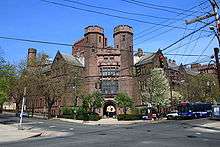Charles C. Haight
Charles Coolidge Haight (1841 – February 9, 1917) was an American architect who practiced in New York City. He graduated from Columbia University in 1861; before working as an architect, he studied law at Columbia Law School. A number of his buildings survive including at Yale University and Trinity College (Hartford, CT). He also designed most of the campus of the Episcopal General Theological Seminary in Chelsea Square, New York. The original brick buildings he designed for Columbia College, at the college's former location on Madison Avenue, no longer survive.
Haight died at his home in Garrison, New York in 1917.[1]
Haight's contributions to both Yale and the Episcopal Seminary remain significant to this day, although at Yale, James Gamble Rogers is more often associated with Yale's collegiate- or neo-gothic style. Haight's architectural drawings and photographs are held in the Dept. of Drawings and Archives at the Avery Architectural and Fine Arts Library at Columbia University in New York City.
Selected works
Buildings at Yale University
- Portions of Silliman College, originally dormitories for Sheffield Scientific School
- Buildings on Old Campus including Vanderbilt Hall , Phelps Hall , and Linsly (part of Linsly-Chittenden Hall)
- Mason Laboratory
- Leet Oliver Memorial Hall
- Sloane Physics Laboratory
- Osborn Memorial Laboratories, 1913, 165 Prospect St, New Haven, CT.
- The house for the Sigma Chapter of St. Anthony Hall, 1913 (a commission for member Frederick William Vanderbilt).
Buildings in New York City
- New York Cancer Hospital (modeled after a French Renaissance château at Le Lude, Sarthe),
- Saint Ignatius of Antioch Episcopal Church[2]
- Second Field Artillery Armory (Bronx)
- General Theological Seminary, 1884–1904[3]
- Brooks Brothers Building 932-938 Broadway, Demolished
- Hamilton Hall, Columbia University, 1880, Demolished
- Library, Columbia University, 1882; Law School, Columbia University, 1882, School of Mines, Columbia University, 1884, All demolished
- 149-151 Franklin Street, 1885
- 55-57 Morth Moore Street, 1890
- Higgins Hall, Pratt Institute, Brooklyn, New York, 1890
- American Music Hall (American Theater), 42nd Street, 1893, Demolished
- Henry Osborne Havemeyer House, One East 66th Street, 1889, Demolished
- Sheltering Arms, 1869, Demolished 1945 (today Sheltering Arms Playground) [4]
- Trinity Parish clergy house, 1887
- Chapel of St. Cornelius the Centurion, 1906, on Governors Island
- 330 Hudson 1910, Renovated in 2014
Buildings outside New York City
- Westbrook, now within Bayard Cutting Arboretum State Park, Great River, Long Island
- Cathedral Church of St. Luke, Portland, Maine
- The Keney Memorial Clock Tower in Hartford, Connecticut[5][6]
Gallery
- New York Cancer Hospital, 1884-1890, located at 455 Central Park West between 105th St and 106th St.
 Saint Ignatius of Antioch Episcopal Church, 1903, at 552 West End Avenue, on the southeast corner of 87th Street.
Saint Ignatius of Antioch Episcopal Church, 1903, at 552 West End Avenue, on the southeast corner of 87th Street.
 General Theological Seminary, the Chapel of the Good Shepherd, built from 1868-1888, Chelsea.
General Theological Seminary, the Chapel of the Good Shepherd, built from 1868-1888, Chelsea. Osborn Memorial Laboratories, 1913, 165 Prospect St, New Haven, CT.
Osborn Memorial Laboratories, 1913, 165 Prospect St, New Haven, CT.
| Wikimedia Commons has media related to Charles C. Haight. |
Notes
- ↑ Levy, Florence Nightingale (1917). American Art Directory, Volume 14. The American Federation of the Arts. p. 323.
- ↑ "Archived copy". Archived from the original on 2007-05-29. Retrieved 2007-01-25.
- ↑ http://www.artnet.com/library/03/0361/T036158.asp
- ↑ http://www.nycgovparks.org/parks/M190/highlights/8271
- ↑ http://www.nationalregisterofhistoricplaces.com/CT/Hartford/state5.html
- ↑ "Archived copy". Archived from the original on 2006-06-17. Retrieved 2007-01-25.
External links
- Charles C. Haight at the archINFORM database.
- Charles Coolidge Haight architectural drawings and papers, circa 1874-1914 Held by the Department of Drawings & Archives, Avery Architectural & Fine Arts Library, Columbia University